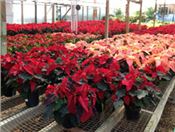How To Care For The Festive Poinsettia Plant During And After The Holiday Season

The vibrant red, green and white foliage and flowers of the poinsettia plant make it a favorite gift and decoration during the holiday season and beyond.
Division of Agriculture photo
REBEKAH HALL
LITTLE ROCK, ARKANSAS
The vibrant red, green and white foliage and flowers of the poinsettia plant make it a favorite gift and decoration during the holiday season and beyond.
The festive plant also has a special connection to Arkansas history: the state’s Poinsett County and the poinsettia plant both derive their names from Joel Roberts Poinsett, a U.S. Congressman and botanist from South Carolina. Poinsett first brought clippings of the poinsettia plant to the United States from its native Mexico in the early 1800s.
Poinsett served as secretary of war under President Martin Van Buren, and though he never visited Arkansas, Poinsett was a friend of Arkansas Congressman Archibald Yell.
The poinsettia’s association with the holiday season is in part due to the plant’s geographical home. Native to southern Mexico, poinsettias are in bloom during this time of year.
“Poinsettia flower buds are initiated as our nights naturally get longer in the fall,” said Berni Kurz, extension consumer horticulture educator for the University of Arkansas System Division of Agriculture. “This is a phototropic response, and we call plants that respond to long nights ‘short day’ plants.”
The poinsettia, with its colorful leaves and bright flowers, has long been included in Mexican celebrations of Christmas. The plant’s popularity in the United States took hold in the 1960s, when the Ecke family – who owned poinsettia nurseries in California – successfully branded poinsettias as the Christmas flower by sending free plants to television studios for their holiday specials, including those of Bob Hope and “The Tonight Show.” With plenty of screen time during Christmas programming, poinsettias then became a holiday staple.
The poinsettia plant’s beauty can be maintained throughout the year with a bit of care and attention from growers – read on to learn how to care for the plant during and after the holidays:
When you first receive it:
• Avoid exposing the plant to extreme heat (above 80 degrees Fahrenheit) or extreme cold (below 50 degrees), as this can cause the plant to lose its leaves or even kill the plant. Cover and protect the plant when transporting it from the florist, greenhouse, or retailer, and once inside, avoid placing the plant near hot or cold drafts.
• Poinsettias are happiest when placed in bright environments, such as near a window, and kept at a moderate temperature (60 to 65 degrees).
• Poinsettias prefer moist soil. When the top of the soil feels dry to the touch, water thoroughly with warm tap water and allow excess water to drain from the bottom of the container. Poinsettias are susceptible to root and stem diseases, so draining the excess water is a key step. If the plant is wrapped with decorative foil, punch a hole in the foil beneath the pot to allow excess water to escape. The plant should be placed on a saucer to prevent damage to the furniture or carpet.
• Though most poinsettias do not require additional nutrients during the holiday season, you can use a standard houseplant fertilizer to maintain healthy foliage and blooms. Follow the fertilizer recommendations listed on the package.
• Poinsettias are not very toxic to pets, though the plant has “received bad press in the past,” Kurz said.
• Kurz said the poinsettias’ milky sap can be a mild irritant to the mouth of pets when the plant is chewed.
After the holidays, this plant can live on in Arkansas:
• Remove any decorative wraps from the planter and place a saucer underneath the plant. This creates better air circulation for the roots during the rest of the growing season.
• Water and fertilize at regular intervals.
• As the plant grows, move it to a larger container with new potting mix.
• If the poinsettia starts to become long and leggy, cut it back 5 to 6 inches. You can also periodically cut the tips of the branches to encourage more side branching and maintain a fuller appearance.
Throughout the year:
• In the summer, move your poinsettia outside to an area with indirect sunlight. This is also the time to increase fertilizer to at least twice the frequency.
• In mid-summer, trim the plant as necessary to keep a manageable size and fullness, and then move to a location with full sunlight.
• After Labor Day, move the plant inside to a location that gets at least six hours of sunlight, preferably more. This helps the plant start preparing for its flowers and colorful foliage. This is also when you should begin reducing the frequency of fertilizer.
• Toward the end of September, your poinsettia needs long periods of darkness to achieve its bright colors. At this stage, it must have at least 13 hours of uninterrupted darkness and 11 hours of bright light each day. Try placing the plant in a basement, a closet, or beneath a box during the required hours of darkness. And during the periods of bright light, be sure to rotate your plant so it receives even light on all sides.
In the days just before Thanksgiving, you can stop the dark periods, reduce the amount of water and fertilizer used, and place your poinsettia in a sunny spot that receives at least six hours of direct light. ∆
REBEKAH HALL: U of A System Division of Agriculture